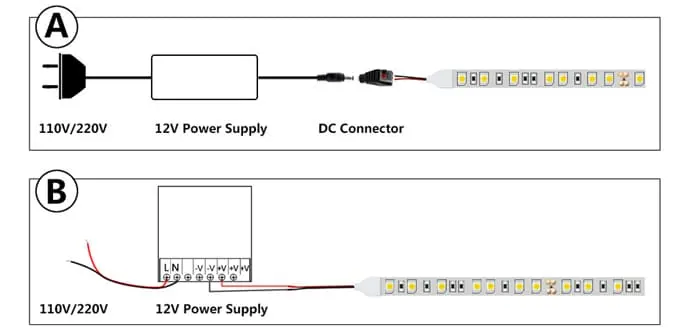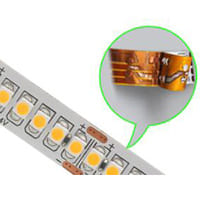Introduction
LED strip lights are popular in lighting design because they’re versatile, energy-efficient, and customizable. There are many kinds, each with its own benefits. In this guide, we’ll talk about the common used different types of LED strip lights, what they’re used for, and their technical details. This will help you pick the right kind for your needs.
Exploring the Different Types of LED Strip Lights
1) Single-color LED Strip
• Definition: Single-color LED strips are the simplest type of LED strip lights. They provide a consistent color of light and do not have the ability to change colors. Available in a variety of colors including white, red, green, blue, and yellow, etc.
• Applications: Ideal for general, accent, and task lighting in both residential and commercial settings due to their straightforward design.
• Simplicity: Easy to install and operate, which makes them perfect for DIY projects. Often come with adhesive tape backing for easy installation without the need for extra mounting hardware.
• Energy Efficiency: Known for consuming less power than traditional lighting sources like incandescent bulbs, resulting in lower energy bills.
• Longevity: LED technology is renowned for its long lifespan, reducing the need for frequent replacements and maintenance.
2) Adjustable White CCT LED Strip
Adjustable white LED strips, known as tunable white CCT LED strips, are a versatile lighting solution that allows you to customize the color temperature to suit your needs. Here’s how they can enhance your space:
• Customizable Color Temperature: These LED strips can show different shades of white, from warm (2700K) to cool (6500K), letting you choose the perfect one for any occasions.
• Mood Setting:
• Warm White (2700K): Creates a cozy, inviting atmosphere similar to traditional incandescent bulbs. Ideal for:
-
-
- Relaxing in living areas
- Enjoying a comfortable dinner
- Winding down before bed
-
• Cool White (6500K): Offers a brighter, more focused light akin to natural daylight. Perfect for:
-
-
- Task lighting in offices
- Illumination in kitchens
- Makeup application or grooming in bathrooms
-
• Wide Applications: Adjustable white LED strips are great for rooms where you might want to change the light:
-
- Kitchens: Change from a cozy morning light to a bright, cool light for cooking and eating.
- Bathrooms: Use a warm light for a calming bath and a cooler light when you’re getting ready.
• Transforming Spaces: Easily adjust the ambiance of any room with a simple control, making these LED strips ideal for:
-
- Multi-functional rooms
- Event spaces
- Homes that adapt to different activities throughout the day
You can easily change your room from a workspace to a relaxing area by using adjustable white LED strip lights. Just adjust the color temperature.RGB LED Strip
3) RGB LED Strips
RGB LED strips add fun colors and movement to your lighting ideas. Here’s why they’re great for creative lighting:
• Color Creation: RGB LED strips use the additive color model to blend red, green, and blue, creating many colors. This lets you:
-
- Make special colors for themed events.
- Adjust lights to fit your decoration or feelings.
• Design Flexibility: The ability to adjust the intensity of each color means you can:
-
- Design vibrant displays for a party atmosphere.
- Settle on subtle tones for relaxed ambiance.
• Unlimited Choices: With lots of colors available, the options are endless. Use RGB LED strips to:
-
- Make building parts stand out with color.
- Make gaming setups or home theaters more fun.
• Mood Setting: RGB LED strips are perfect for:
-
- Creating a romantic atmosphere with soft, changing colors.
- Enhancing the energy of a space with bright, dynamic patterns.
• Easy Control: Pick from different ways to control your RGB LED strips, like:
-
- Remote controllers for easy use.
- Smartphone apps for changes anytime, anywhere.
- Special lighting controllers for detailed and tricky sequences.
• Entertainment Integration: Sync your RGB LED strips with:
-
- Music used for light shows that follow the rhythm.
- Movies, to spread the colors of the screen into the room.
RGB LED strips are not just about lighting; they’re about making a statement. Whether it’s for a festive occasion or everyday enjoyment, these strips transform your space with the magic of color.
4) RGBW LED strips
RGBW LED strips are an innovative lighting solution that enhances the standard RGB capabilities with an additional white LED. Here’s why they’re making a big difference in LED lighting:
• Improved Color Range: By integrating a white LED, RGBW strips offer:
-
- A wider color range for designing detailed lighting.
- The capability to create soft and pastel colors, which are hard to achieve with just RGB.
• Richer Color Blends: The addition of white light means you can:
-
- Get better color changes and blends.
- Mix colors with greater depth and variation, perfect for artists and designers.
• Pure White Lighting: Unlike RGB strips, RGBW strips can provide:
-
- Clean, white light for tasks that require clarity and high visibility.
- A neutral backdrop, allowing for accurate color rendering in photography or display settings.
• Dual Functionality: RGBW LED strips serve a dual purpose:
-
- Bright, colorful lights for when you want to stand out.
- Basic white lights for regular use or when you want something simple.
• Customizable Ambiance: With RGBW strips, you can tailor the ambiance of any space:
-
- Warm white for a cozy, inviting atmosphere.
- Cool white for a crisp, modern vibe.
• Energy Efficiency: Combining colors with white light can also be more energy-efficient, as you can:
-
- Use less power to create certain shades by leveraging the white LED.
- Rely on the white LED alone for a bright light without the added energy consumption of color mixing.
• Seamless Integration: RGBW LED strips can easily be incorporated into:
-
- Home automation systems for smart, responsive lighting.
- Professional lighting setups for events and entertainment.
RGBW LED strips are not just an addition to your lighting options; They change what we thought was possible with LED lights, providing unmatched flexibility for creative lighting.
5) Addressable LED Strips
Addressable LED strips, also known as Pixel RGB strips, take the customization possibilities of LED strip lights to a whole new level. Here’s how they open up a universe of creative possibilities:
• Individual Pixel Control: Each pixel can be controlled independently, allowing for:
-
- Precise lighting effects tailored to your specific design needs.
- The creation of complex and detailed lighting patterns.
• Dynamic Visual Displays: With addressable LED strips, you can:
-
- Choreograph flowing color gradients that transition smoothly across a space.
- Program vibrant animations that bring energy and movement to any environment.
• Artistic Flexibility: These strips are ideal for:
-
- Architectural lighting that requires a high level of detail and customization.
- Stage lighting where dramatic effects can enhance a performance.
- Art installations that rely on interactive and engaging light displays.
• Advanced Control Systems: To make the most out of them, addressable LED strips are usually used with:
-
- Specialized lighting controllers for professional setups.
- DIY project enthusiasts and hobbyists often use microcontrollers such as Arduino or Raspberry Pi.
• Easy Programming: These strips are a bit more technical, but offer:
-
- The chance to show scrolling text for messages or ads.
- The option to match the lights with music or other sounds.
• Limitless Creativity: The true power of addressable LED strips lies in their ability to:
-
- Transform any space into a canvas for your imagination.
- Create an immersive experience that can be continually updated and refined.
Addressable LED strips are not just for lighting. They are a platform for creativity, letting designers, artists, and hobbyists do more than just traditional lighting.
Customization and Technical Specifications
1) Voltage for Different Types of LED Strip Lights

LED light strips come in different voltage types, like 12V, 24V, 36V, 48V, 220V, etc. The right voltage for you depends on the type of LED strip, its length, and how much power your project needs.
12V LED strips are very common and great for smaller projects and shorter strips. They’re often used in homes for things like under-cupboard lights, accent lights, or decorative lights. These strips need a power supply unit (PSU) to change the main power supply down to 12V.
24V LED strips are usually used for bigger projects and longer strips. They work better and lose less voltage than 12V LED strips. They’re often used in businesses for things like store displays, signs, and building lighting. Like the 12V strips, they need a PSU to change the main power supply down to 24V.
When picking the voltage for your LED strips, think about the total power used, the length of the strip, and how much voltage is lost along the strip. Voltage is lost along the strip because of the resistance in the material that carries the power. To lose less voltage, use thicker and shorter power lines and spread the power evenly along the strip.
2) LEDs Types

LED strip lights are simply a string of tiny lights called LEDs on a flexible board. The kind of LED used affects the light’s color, brightness, and how much energy it uses. There are many types of LEDs, each with its own features.
The most common type in LED strip lights is SMD LEDs. They’re small, bright, and show colors accurately. There are different sizes of SMD LEDs: SMD 3528, SMD 5050, and SMD 2835. The numbers show the size of the LED chip.
SMD 3528 LEDs are the smallest and not very bright. They’re often used in LED strips with one color and don’t give off as much light as others. SMD 5050 LEDs are bigger and brighter, good for LED strips with multiple colors. SMD 2835 LEDs are about the same size as SMD 3528 LEDs but they’re brighter and more efficient.
Another kind of LED in strip lights is the high-power LED. These are bigger and stronger than SMD LEDs, giving off more light. They’re often used in professional LED strips that need to be very bright. These are typically used outdoors, in architectural lighting, and for businesses.
When choosing an LED for your strip lights, think about how bright you want them, how accurately they need to show color, and how much energy they should use. SMD LEDs are a popular choice because they’re small, work well, and are easy to find.
3) PCB Materials

The material of the PCB in LED strip lights is important for their performance and flexibility. The PCB is where the LEDs are placed and it connects them electrically. Different PCB materials have different features.
Flexible PCB is often used for LED strip lights. It’s a mix of copper and plastic layers that can bend easily. This makes it easy to shape the LED strip as needed. FPCB also helps the LEDs stay cool by conducting heat away.
Another type of PCB material is aluminum-backed. It has an aluminum layer that helps with heat management. This is useful for high-power LED strips that need to stay cool to work well. These kinds of strips are used in outdoor lights, industrial settings, and professional installations.
When picking the PCB material for your LED strips, think about how flexible you need it to be, how well it manages heat, and how long it lasts. FPCB is a common choice because it’s flexible, conducts heat well, and is cost-effective. But, if you need something more powerful or for tough conditions, an aluminum-backed PCB might be best.
By understanding these specifications, you can easily identify the quality of LED strip lights.
Conclusion
In short, there’s a wide variety of LED strip lights out there for different lighting needs. You’ve got everything from warm single-color strips to colorful addressable RGB pixels. Each kind serves a unique purpose and can be used for specific needs. The key is to choose the right type for your project. This way, you can make sure it not only looks good but also functions well. LED strip lights are great because they’re energy-efficient, long-lasting, and highly customizable. They’re a great choice whether you’re a professional designer or a DIY fan looking to enhance your lighting design.
Author
-

I'm Joseph, the Co-founder of CST Lighting, bringing over a decade of expertise in the LED lighting industry. With a strong focus on product marketing, I am dedicated to staying at the forefront of market trends, constantly enhancing my knowledge and skills to deliver top-notch products and services to our clients. Through our insightful blog posts, we strive to share our expertise, guiding readers through the ever-evolving landscape of LED lighting.
View all posts
Learn more via my linkedin profile https://www.linkedin.com/in/ledcst-joseph/